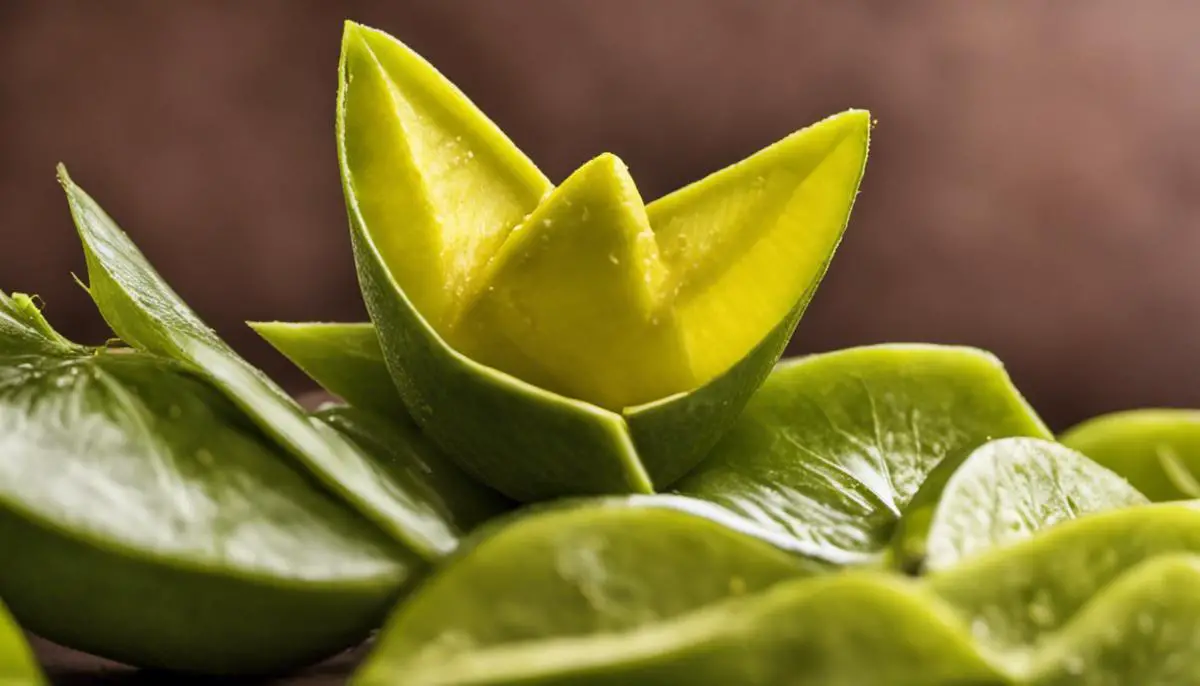For those living with diabetes, finding indulgences that can intertwine seamlessly with dietary necessities can seem challenging. Understanding these challenges, we delve into an exploration of the unique fruit carambola, also known as star fruit. Laden with numerous health benefits, carambola is a tropical fruit, not just appreciated for its unique shape and pleasant taste, but also admired for its nutritional and health benefits, particularly for those with diabetes. Our exploration travels from the very roots of this fruit, tracing its historical culinary purposes, and dismantling its nutritional make-up, to truly expose the scope of its health benefits. Most notably, we will discuss carambola’s influence on blood sugar control, the crux of diabetic care, offering a fresh perspective on this often overlooked fruit.
Understanding Carambola
Carambola: An Overview
Carambola, or star fruit, is a tropical fruit that is low in calories but high in nutrients. The fruit is indigenous to Southeast Asia but is grown in various tropical regions across the world, including the United States. It earned its name “star fruit” as a result of its star-shaped cross-section when cut. The golden-yellow fruit has a tangy taste that is a pleasant mix of sweet and sour.
Nutritional Content of Carambola
One of the key features of carambola is its nutritional value. For a fruit low in calories and fats, it is surprisingly packed with vital nutrients. It is an excellent source of dietary fibers, with nearly 3g present per 100g of the fruit. Vitamins are plentiful within it too, particularly Vitamin C. In fact, a single serving of carambola can provide up to 57% of the daily recommended intake of Vitamin C. For diabetic patients, Vitamin C is especially beneficial as it helps in regulating the body’s blood sugar level.
Carambola also comprises several important minerals such as potassium, zinc and iron, all of which are essential to fostering a healthy body. Potassium helps to lower blood pressure, decrease cardiovascular diseases and enhance the body’s metabolism, all while controlling the body’s electrolyte functions.
Antioxidant Properties
Star fruit is known for its high antioxidant content. Antioxidants are molecules that neutralize potentially harmful chemicals in the body, also known as free radicals. In excess, these free radicals can cause inflammation and damage cells, potentially leading to disease. A diet rich in antioxidants can help protect against diseases such as diabetes, cancer and heart disease. Carambola, being high in antioxidants, can help protect the body from developing such diseases.
Carambola and Diabetes Management
Carambola’s low sugar content makes it a great choice for individuals experiencing diabetes. It has a glycemic index (GI) of a mere 41 (anything below 55 is regarded as low). Foods with a low GI are beneficial to diabetes patients as they lead to a smaller rise in blood glucose levels compared to foods with a high GI.
Star fruit’s high fiber content, coupled with its low GI, can effectively slow down the release of glucose into the bloodstream. This slow release helps prevent the sudden rise of blood sugar levels, thereby keeping glucose levels steady and manageable. For diabetic patients, this is especially beneficial, allowing for better control and management of their condition.
Introduction to Diabetic-Friendly Benefits of Carambola
Carambola, also referred to as star fruit, is a unique fruit both in terms of its starlike shape and its sweet yet tangy flavor. With its abundant health benefits, carambola can potentially play a significant role in any health-conscious diet, including a diabetic-friendly one. However, individuals, especially those with pre-existing medical conditions, should be cautious and moderate in consumption due to its high Oxalic acid content, which may adversely affect those with kidney issues and other related conditions. Specifically, individuals with diabetes considering integrating star fruit into their diet should first consult with a healthcare professional to ensure the change does not compromise their overall health.

Carambola and Blood Sugar Control
Roll of Carambola in Blood Sugar Control
In addition to being an uplifting addition to your palate, carambola has some potential health benefits that may be particularly helpful for individuals managing their diabetes. The star fruit is known for its ability to help control blood sugar levels, making it an especially valuable dietary addition for those dealing with this common chronic conditions.
Scientific Appraisal of Carambola and Blood Sugar Control
Carambola’s effects on blood glucose control have been supported by scientific studies. A 2015 study published in the Journal of Food Science established that compounds present in carambola can inhibit the enzymes, alpha-glucosidase and alpha-amylase, which are responsible for breaking down complex carbohydrates into sugars. This inhibitory action slows down the rate of carbohydrate digestion, delaying the rise in blood sugar that follows meals – a particularly vital function for diabetics, who have trouble controlling blood glucose fluctuations.
The Role of Low Glycemic Index in Diabetes
Fruits like carambola with a low glycemic index (GI) are highly beneficial for diabetics. The glycemic index is a scale that ranks carbohydrates in foods on a scale of 0 to 100, based on how much they raise blood sugar levels after eating. Foods with a high GI cause a faster and higher rise in blood glucose levels. Carambola has a low glycemic index, meaning that it affects your blood sugar levels to a lesser degree, making it easier to prevent blood sugar spikes. A diet that includes low-GI foods, like carambola, can be a helpful tool in managing diabetes effectively.
Carambola’s High Fiber Content: A Plus for Diabetes Management
Another standout feature of carambola is its high fiber content. Diets rich in fiber have a beneficial impact on blood sugar control, as fiber slows digestion and the rate at which carbohydrates are absorbed into the bloodstream. This function allows for a more gradual, controlled release of glucose into the bloodstream, preventing sudden surges in blood sugar levels.
Therefore, the fiber-enriched carambola can contribute to better glucose control in individuals living with diabetes and lower the risk of developing diabetes-related complications.
A Closer Look: Carambola’s Role in a Diabetic Diet
Integrating carambola into a balanced and diverse diet may go a long way in managing blood sugar levels, particularly for those living with diabetes. As with all foods, it’s important to consume carambola moderately. Regular physical activity should also supplement a healthy diet to effectively manage diabetes.
The delightful freshness and tangy flavor of carambola, together with its distinctive star shape, gives a fun addition to salads and other culinary concoctions. This engages the palate while offering health benefits. Before incorporating any new food into their diet, individuals managing diabetes are always encouraged to seek advice from health professionals or dieticians.

Other Diabetic-Friendly Benefits of Carambola
Heart Health and Carambola
The heart health benefits of carambola, more commonly known as the star fruit, are tied to its rich dietary fiber and antioxidant content. These help in reducing levels of LDL, the ‘bad’ cholesterol, hence lowering the risk of atherosclerosis, and subsequent heart diseases. Potassium-rich carambola also aids in managing elevated blood pressure, a typical challenge for those with diabetes. Hence, by promoting heart health, carambola offers benefits that are particularly crucial for individuals with diabetes who are at a greater risk of cardiovascular diseases.
Antioxidant Properties of Carambola
Carambola is high in flavonoids and other antioxidant compounds such as quercetin, gallic acid, and epicatechin. These substances can combat oxidative stress, which is elevated in people with diabetes, leading to damage of cells, proteins, and DNA. By counteracting the effects of oxidative stress, the antioxidants in carambola may help to protect against the progression of diabetes and its complications.
Carambola for Weight Management
Being low in calories and high in fiber, carambola can be beneficial for weight management. It helps to promote feelings of fullness and can reduce overall energy intake, which is crucial in managing type 2 diabetes. Maintaining a healthy weight is important to manage blood sugar levels and to decrease the risk of developing other health complications related to diabetes.
Carambola in a Balanced Diabetic Diet
Carambola can be included in a balanced diabetic diet as it has a low glycemic index (GI). Foods with a low GI release glucose more slowly and steadily. This helps in managing blood glucose levels and preventing blood sugar spikes. Additionally, carambola is rich in Vitamin C and other essential nutrients that can help meet the nutritional requirements of individuals with diabetes.
Incorporating Carambola in Daily Meals
There are a lot of creative ways to incorporate carambola into daily meals. It can be used in salads, salsas, smoothies, and desserts, or simply eaten fresh as a snack. It’s important to remember that while carambola can be part of a healthy diet for people with diabetes, it should be consumed in moderation. Like all fruits, carambola contains natural sugars, which can affect blood sugar levels if consumed in excess.
Precaution Regarding Carambola
Despite its potential benefits, carambola can be harmful to some individuals with kidney problems, a condition often associated with diabetes. This is due to its high content of oxalic acid, which can lead to the formation of kidney stones or other complications. Therefore, individuals with kidney diseases should avoid consuming carambola. It’s always best to seek advice from a healthcare provider before making any significant dietary changes.

Through the course of our exploration, the versatile carambola has proven to be more than just a stellar delight to the senses. Beyond its low glycemic index and rich fiber content that contribute to blood sugar control, this star fruit shines in its array of other diabetic-friendly benefits – heart health, weight management, and potent antioxidant properties. The presence of carambola in a balanced diabetic diet offers not just variety and enjoyment, but tangible benefits for health and wellbeing. As we continue striving to understand and manage diabetes, let’s embrace the carambola in our dietary routines, harnessing the power of nature to transform our daily meals into nourishing steps on the path to better health.
